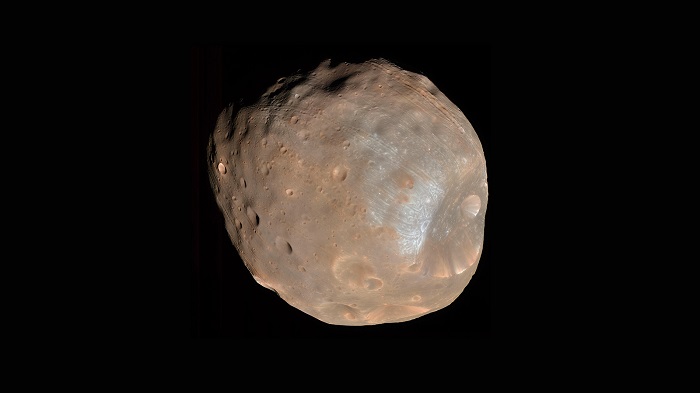What is Phobos? What are the characteristics of Phobos, one of the moons of Mars? The structure of Phobos, interesting information about Phobos.

Phobos
Phobos is one of the two small natural satellites of Mars, the other being Deimos. It is the larger of the two, with a mean radius of about 11 km and an average distance from Mars of about 9,378 km. It has an orbital period of about 7.6 hours, meaning it takes about 7.6 hours for Phobos to orbit Mars once.
Phobos has a heavily cratered surface, with a number of large impact craters, grooves, and linear features. The largest crater, Stickney, is about 9 km in diameter and about 2 km deep. The surface of Phobos is also covered in a layer of fine dust and small rocks, which is thought to have been created by the impacts of micrometeoroids.
Phobos has a heavily cratered surface, with a number of large impact craters, grooves, and linear features. The largest crater, Stickney, is about 9 km in diameter and about 2 km deep. The surface of Phobos is also covered in a layer of fine dust and small rocks, which is thought to have been created by the impacts of micrometeoroids. Phobos is also known to have a very low density, which is indicative of a porous structure and suggests that it may be a rubble pile held together by a relatively thin layer of regolith.
Phobos has a heavily cratered surface, with a number of large impact craters, grooves, and linear features. The largest crater, Stickney, is about 9 km in diameter and about 2 km deep. The surface of Phobos is also covered in a layer of fine dust and small rocks, which is thought to have been created by the impacts of micrometeoroids. Phobos is also known to have a very low density, which is indicative of a porous structure and suggests that it may be a rubble pile held together by a relatively thin layer of regolith.
Phobos has been studied by a number of spacecraft, including the Viking orbiters, the Mars Reconnaissance Orbiter, and the Mars Express. These missions have provided detailed images and data on the satellite’s surface, composition, and geology. Scientists are also interested in studying Phobos as a potential destination for future manned missions to Mars. The study of Phobos can help us understand the geology of Mars, the history of its satellite system, and the conditions that may have existed on the Martian surface in the past.
Phobos is also considered as a potential destination for future manned missions to Mars, as it is relatively large and its surface is thought to be relatively stable and safe for landing. It could serve as a valuable resource for scientists, as it could contain information about the history of Mars and the conditions that existed on the planet in the past.
It is also worth to note that recent studies suggest that Phobos is a captured asteroid, and not a natural Martian satellite, this hypothesis is still under research and not confirmed yet.
Characteristics
Here are some of the key characteristics of Phobos:
- Phobos is the larger of the two natural Martian satellites, with a mean radius of about 11 km.
- Its average distance from Mars is about 9,378 km, and it has an orbital period of about 7.6 hours.
- Phobos has a heavily cratered surface with a number of large impact craters, grooves and linear features. The largest crater, Stickney, is about 9 km in diameter and about 2 km deep.
- The surface of Phobos is also covered in a layer of fine dust and small rocks, thought to have been created by the impacts of micrometeoroids.
- Phobos has a very low density, indicative of a porous structure, and it’s thought to be a rubble pile held together by a relatively thin layer of regolith.
- Phobos has been studied by multiple spacecraft, providing detailed images and data on its surface, composition and geology.
- Scientists consider Phobos as a potential destination for future manned missions to Mars because it is relatively large and its surface is thought to be relatively stable and safe for landing.
- There is also a hypothesis that Phobos is a captured asteroid and not a natural Martian satellite.
It’s worth noting that the study of Phobos can help us understand the geology of Mars, the history of its satellite system, and the conditions that may have existed on the Martian surface in the past.